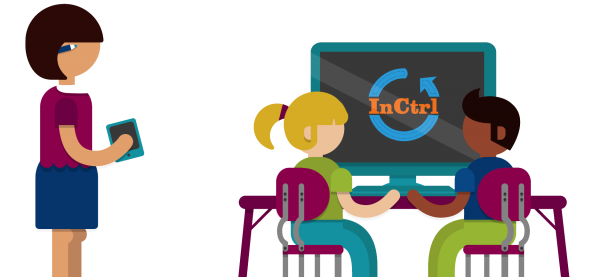The subject of Science provides several opportunities to integrate important digital citizenship topics and connections to InCtrl lessons.
Science and Digital Tools: Use digital media and tools to promote science skills, good research habits, fact checking, citation, presentation and communication skills.
- Create a digital lab notebook (on a Wiki page for instance) or a digital library/portfolio of notes, experiments, resources, images, etc
- Have students create a presentation to demonstrate knowledge, research, or demonstrate a lab.
- Think of how students can use PowerPoint, iMovie, or create a poster, PSA or podcast to present their research or a project as a summative assessment.
- Brainstorm ways that your class can use digital meeting or communication technologies such as GoToMeeting, Skype, or Google Hangouts. For example, conduct “field” research or watch a lab virtually conducted virtually.
“The InCtrl Lesson “Working Together Digitally” is a great lesson to use in Science because [students] are always doing their labs or experiments in groups. At times these groups need to work together online in order to complete their tasks. I also reinforced that working together is something they use in daily life as they continue to get older.”
Teacher, Virginia
“In this day and age, I think digital citizenship is an extremely important topic. The digital lives of our students will affect them profoundly. We need to prepare our students so they have the tools to navigate our digital world in a safe and productive manner.”
Teacher, New York
Lesson Idea Starters
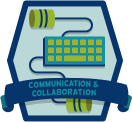
Use this lesson to help students explore different ways and tools they can use to collaborate and work on a project together, doing research, and conducting a lab.
Discuss how scientists and researchers working in different locations around the world collaborate regularly on research, papers, labs and projects using collaborative digital tools.
- The Harvard University-led Personal Genome Project
- The National Audubon Society’s Christmas Bird Count which gathers data for its bird census to help with research and conservation efforts
- Test My Brain which aims to gather research on how the human brain works through quizzes, tests and questionnaires
- Curio which brings experts and citizens together to perform large-scale science projects that cannot be done in one location
- Fold It is an online computer game exploring protein folding in order to gather research and gain insight into how proteins work in the human body, how they interact with drugs in order to get closer to a cure for diseases such as Alzheimer’s, HIV/AIDS, and cancer.
- Open Street Map is a global community-built map, which maintains and contributes to mapping data such as roads, trails, railways, stations, cafes, and more around the world.
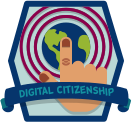
Create an anchor chart with guidelines and tips at the beginning of the year for how to act as a responsible science student online and when doing research.
Discuss various digital science-related scenarios that students may find themselves in, and how to respond. For example, ask: What digital tools and behaviors can you use to help you in science? What behaviors and digital tools may be unhelpful, problematic, or not beneficial in the field of science? List the various science careers that exist today (including computer science).
Interview or invite a scientist or researcher within the community to talk about how they use technology in their field and day-to-day lives.
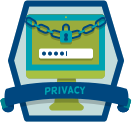
List the various science-related sites and social media students use for homework, research, or for fun. Discuss how everything can be potentially seen by teachers, parents, coaches, colleges, and employers.
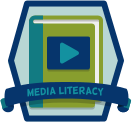
Look at any digital simulations or games related to science. Study the environments represented. Ask: Are they realistic and accurate representations of ecosystems? Do they simplify things, or eliminate some aspects? How does this impact what a user or player will learn?
- Discuss the intentions of the chart, map, illustration, or photo. Ask: What information is published, and what is left unpublished? Who makes this decision? Who created it? How do we know the representation of information is accurate? Was it edited? What are they really trying to say?
- Discuss how graphs can be misleading. The same information can be interpreted in various ways if displayed in different types of chart (i.e. bar graph vs. pie chart). Other elements of a chart that can change its interpretation: Title, scale, labels, source of data, key to pictograph, and size of symbols. See examples here and here. How can subtle changes of graph elements change the interpretation of information? Provide students with a set of data to graph. Have them determine what scale, labels, and elements to include. Compare their results and how differently individual representations of data varied, and why.
- If studying the weather, for instance, discuss how the role of media in informing the public about expectations. Take a look at weather-related photos that made it into the news or online, like those published after Hurricane Katrina, earthquake in Haiti, the tsunami in Japan, and Hurricane Sandy. Ask if students think they are real photos and faux-tos (fake photos). Ask: What story do they tell? What impact does this image have? How do you evaluate the truth? (Visit Snopes for specific and documented examples with sources debunking or validating media images or stories.)
Study different advertisements that use “scientific” research, language, or data. For instance, look at ads for vitamins, medicines, or foods, and compare apps, tools or gadgets that use scientific information. Ask: What makes the ad reliable or unreliable? What influence do the design elements, such as colors or images, have on your interpretation of the content?
- Regarding the weather, ask: How is the weather report created? Who actually predicts the weather? Is the person delivering the report actually a meteorologist or just a face? Is the person doing the report live or was it previously recorded?
- Regarding climate change, ask: What are the schools of thought on climate change? What are the facts? What are the motives behind each school of thought?
- Regarding endangered species or extinction: How do scientists determine what animal or species is endangered or extinct? How do they gather their information? How do we know this accurate? Are some animals more “protected” than others? Why do sharks have such a bad name if some of them are endangered?
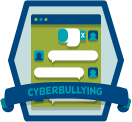
Discuss various sites that students use for science and interact with others, such as YouTube or comment boxes on websites for example. Talk about comments and how to interact respectfully with others. Ask students to think about topics or information could elicit stronger responses from viewers or readers.
- To start, evaluate the following New Jersey school study from 2008 that evaluated students’ attitudes about cyberbullying: www.youthhealthsafety.org/BullyNJweb.pdf
- Next, have students compare findings to another study: http://cyberbullying.us/cyberbullying-research-2013-update
- Ask: What types of statistics do the various studies communicate? Is the data that is represented graphically accurate? Are there “trends”? Is the study fair in capturing an accurate sample of information or data? Do the results of this study match up to your own personal experience? Do you agree with the research and their conclusions?
- Compare the representative samples of research studies. Discuss how scientific studies differ from “opt-in”, online surveys, and surveys that pay participants. How do these differences impact the validity of the survey?
- Use experimental design to conduct your own class research, and gather data on cyberbullying. Compare to other studies on the topic.
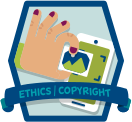
Have students think about how citations can benefit them. For example, citations can establish credibility and authority.
Do a lesson on how take good notes, cite resources and creators of images and research properly, and how to complete a bibliography.
Have students create a presentation or “mash-up” of images and facts about their science topic (using PowerPoint or Keynote) and practice crediting each picture, song, transition, etc. For example, if studying weather: tornadoes, hurricanes, tides, phases of the moon, etc. Explain that just because it is “research”, is based on facts, and is noted by several sources, doesn’t mean a source should not be credited.
Use the apps Explain Everything or SnapGuide to create a tutorial to demonstrate what they have learned about a topic, how something works, how to conduct a lab, or how to credit a creator, researcher, author or scientist.
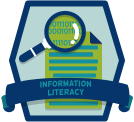
Explore the origin or scientific methodology such as the Science Method, Design Cycle, or Experimental Design Diagram, and how these processes were developed to ensure factual and accurate data collection, research, and information generation and evaluation.
- Variations and the evolution of measurement scales, systems, and accuracies.
- The evolution of understanding in astronomy and the solar system, from the understanding that the sun revolved around the earth to the current facts of the solar system.
- The changes of medical practices understandings of how the body works, causes of diseases, cures and treatments.
- Geographical representation, mapping, weather-related information and accuracy have evolved with the invention of satellites, space advances, and become available for everyone with tools like Google Earth.
Create a Wiki or collaborative spreadsheet (using Google Docs) of resources to use for future projects or to organize your students’ research. For instance, if your class is doing to do a research report on animals, collaborate and create a class wiki of useful and appropriate resources for each animal that might be studied.

